Analyzing Paul's Case: Developmental Psychology Theories Application
VerifiedAdded on 2023/01/19
|11
|3052
|33
Case Study
AI Summary
This paper presents a case study of Paul, a character from Willa Cather's short story, exploring his development through the application of developmental psychology theories. The analysis focuses on Paul's strengths, weaknesses, and challenges as he navigates various life stages. The paper identifies and critically evaluates the application of Jean Piaget's cognitive development theory and Albert Bandura's social learning theory to Paul's experiences, particularly focusing on the influence of his environment, family dynamics, and social interactions on his emotional, cognitive, and physical development. It examines themes such as nature versus nurture, the impact of social learning, and the interplay of these factors in shaping Paul's personality and behavior. The study highlights how Paul's lack of social support and adverse childhood experiences, including domestic violence and parental substance abuse, affected his development and ability to interact with peers, and contrasts his experiences with the principles of cognitive and social learning theories. The paper concludes by emphasizing the importance of understanding these theories to comprehend the complexities of human development and the factors that contribute to a child's well-being.

Development psychology
Name
Institution
Professor
Course
Date
Name
Institution
Professor
Course
Date
Paraphrase This Document
Need a fresh take? Get an instant paraphrase of this document with our AI Paraphraser
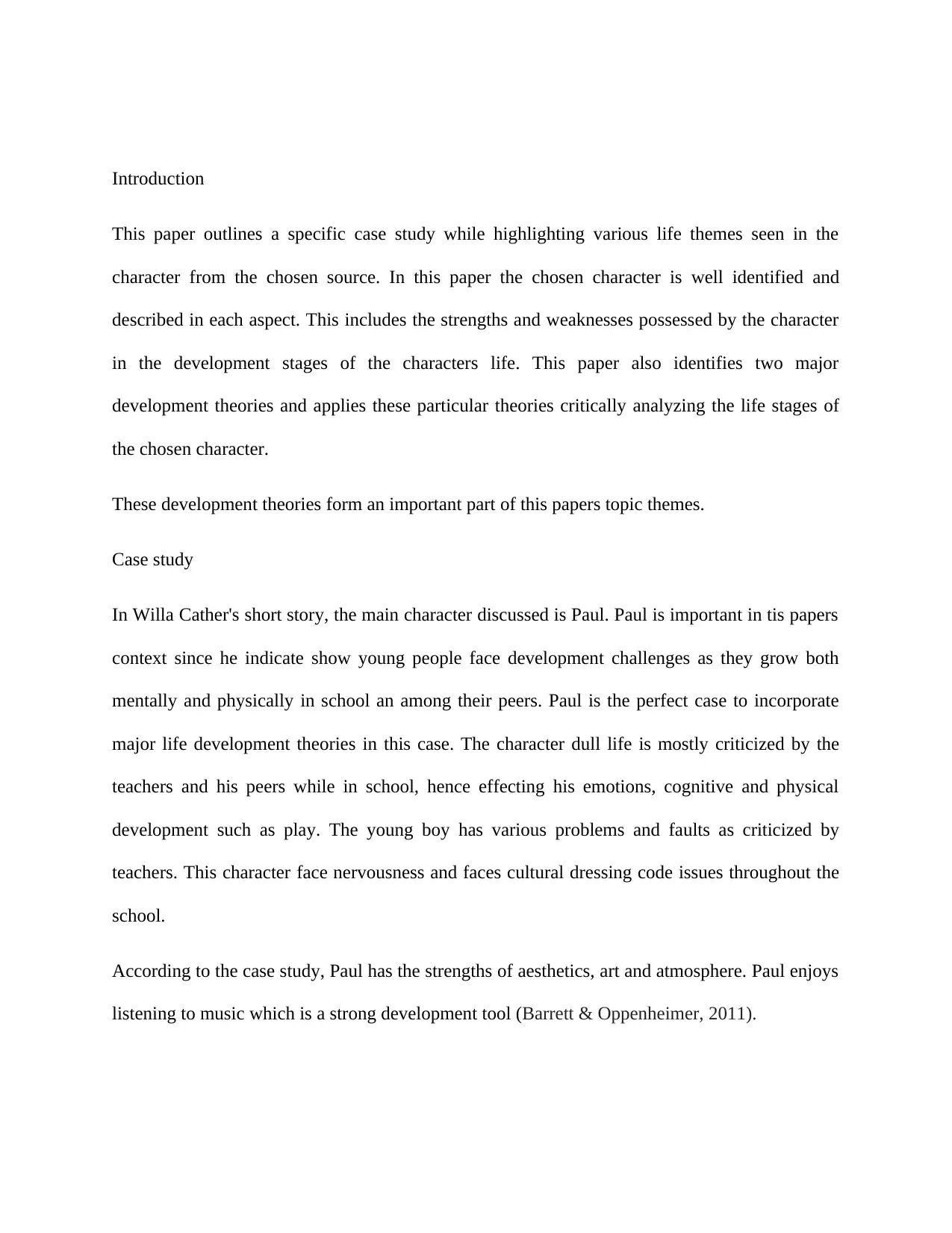
Introduction
This paper outlines a specific case study while highlighting various life themes seen in the
character from the chosen source. In this paper the chosen character is well identified and
described in each aspect. This includes the strengths and weaknesses possessed by the character
in the development stages of the characters life. This paper also identifies two major
development theories and applies these particular theories critically analyzing the life stages of
the chosen character.
These development theories form an important part of this papers topic themes.
Case study
In Willa Cather's short story, the main character discussed is Paul. Paul is important in tis papers
context since he indicate show young people face development challenges as they grow both
mentally and physically in school an among their peers. Paul is the perfect case to incorporate
major life development theories in this case. The character dull life is mostly criticized by the
teachers and his peers while in school, hence effecting his emotions, cognitive and physical
development such as play. The young boy has various problems and faults as criticized by
teachers. This character face nervousness and faces cultural dressing code issues throughout the
school.
According to the case study, Paul has the strengths of aesthetics, art and atmosphere. Paul enjoys
listening to music which is a strong development tool (Barrett & Oppenheimer, 2011).
This paper outlines a specific case study while highlighting various life themes seen in the
character from the chosen source. In this paper the chosen character is well identified and
described in each aspect. This includes the strengths and weaknesses possessed by the character
in the development stages of the characters life. This paper also identifies two major
development theories and applies these particular theories critically analyzing the life stages of
the chosen character.
These development theories form an important part of this papers topic themes.
Case study
In Willa Cather's short story, the main character discussed is Paul. Paul is important in tis papers
context since he indicate show young people face development challenges as they grow both
mentally and physically in school an among their peers. Paul is the perfect case to incorporate
major life development theories in this case. The character dull life is mostly criticized by the
teachers and his peers while in school, hence effecting his emotions, cognitive and physical
development such as play. The young boy has various problems and faults as criticized by
teachers. This character face nervousness and faces cultural dressing code issues throughout the
school.
According to the case study, Paul has the strengths of aesthetics, art and atmosphere. Paul enjoys
listening to music which is a strong development tool (Barrett & Oppenheimer, 2011).
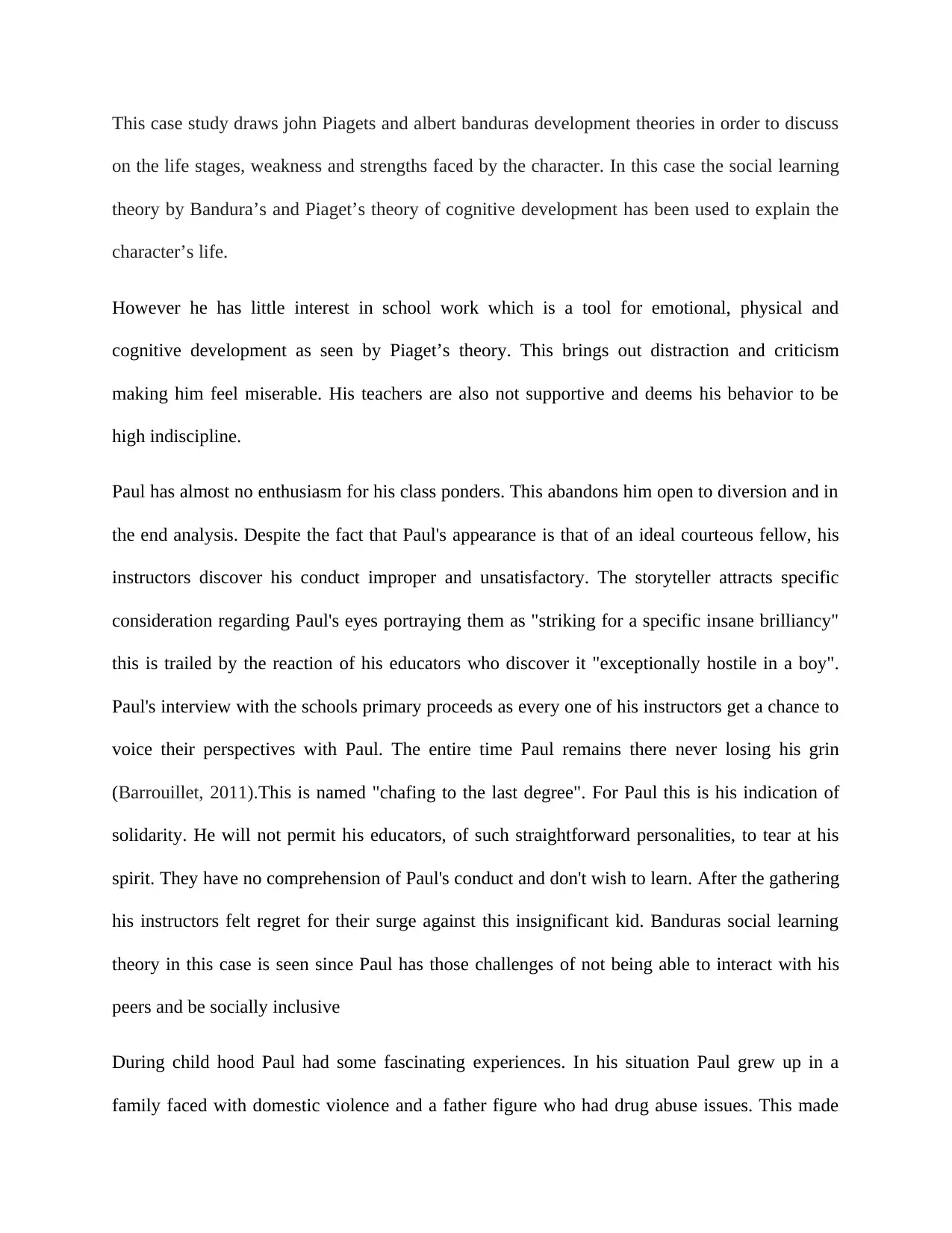
This case study draws john Piagets and albert banduras development theories in order to discuss
on the life stages, weakness and strengths faced by the character. In this case the social learning
theory by Bandura’s and Piaget’s theory of cognitive development has been used to explain the
character’s life.
However he has little interest in school work which is a tool for emotional, physical and
cognitive development as seen by Piaget’s theory. This brings out distraction and criticism
making him feel miserable. His teachers are also not supportive and deems his behavior to be
high indiscipline.
Paul has almost no enthusiasm for his class ponders. This abandons him open to diversion and in
the end analysis. Despite the fact that Paul's appearance is that of an ideal courteous fellow, his
instructors discover his conduct improper and unsatisfactory. The storyteller attracts specific
consideration regarding Paul's eyes portraying them as "striking for a specific insane brilliancy"
this is trailed by the reaction of his educators who discover it "exceptionally hostile in a boy".
Paul's interview with the schools primary proceeds as every one of his instructors get a chance to
voice their perspectives with Paul. The entire time Paul remains there never losing his grin
(Barrouillet, 2011).This is named "chafing to the last degree". For Paul this is his indication of
solidarity. He will not permit his educators, of such straightforward personalities, to tear at his
spirit. They have no comprehension of Paul's conduct and don't wish to learn. After the gathering
his instructors felt regret for their surge against this insignificant kid. Banduras social learning
theory in this case is seen since Paul has those challenges of not being able to interact with his
peers and be socially inclusive
During child hood Paul had some fascinating experiences. In his situation Paul grew up in a
family faced with domestic violence and a father figure who had drug abuse issues. This made
on the life stages, weakness and strengths faced by the character. In this case the social learning
theory by Bandura’s and Piaget’s theory of cognitive development has been used to explain the
character’s life.
However he has little interest in school work which is a tool for emotional, physical and
cognitive development as seen by Piaget’s theory. This brings out distraction and criticism
making him feel miserable. His teachers are also not supportive and deems his behavior to be
high indiscipline.
Paul has almost no enthusiasm for his class ponders. This abandons him open to diversion and in
the end analysis. Despite the fact that Paul's appearance is that of an ideal courteous fellow, his
instructors discover his conduct improper and unsatisfactory. The storyteller attracts specific
consideration regarding Paul's eyes portraying them as "striking for a specific insane brilliancy"
this is trailed by the reaction of his educators who discover it "exceptionally hostile in a boy".
Paul's interview with the schools primary proceeds as every one of his instructors get a chance to
voice their perspectives with Paul. The entire time Paul remains there never losing his grin
(Barrouillet, 2011).This is named "chafing to the last degree". For Paul this is his indication of
solidarity. He will not permit his educators, of such straightforward personalities, to tear at his
spirit. They have no comprehension of Paul's conduct and don't wish to learn. After the gathering
his instructors felt regret for their surge against this insignificant kid. Banduras social learning
theory in this case is seen since Paul has those challenges of not being able to interact with his
peers and be socially inclusive
During child hood Paul had some fascinating experiences. In his situation Paul grew up in a
family faced with domestic violence and a father figure who had drug abuse issues. This made
⊘ This is a preview!⊘
Do you want full access?
Subscribe today to unlock all pages.

Trusted by 1+ million students worldwide
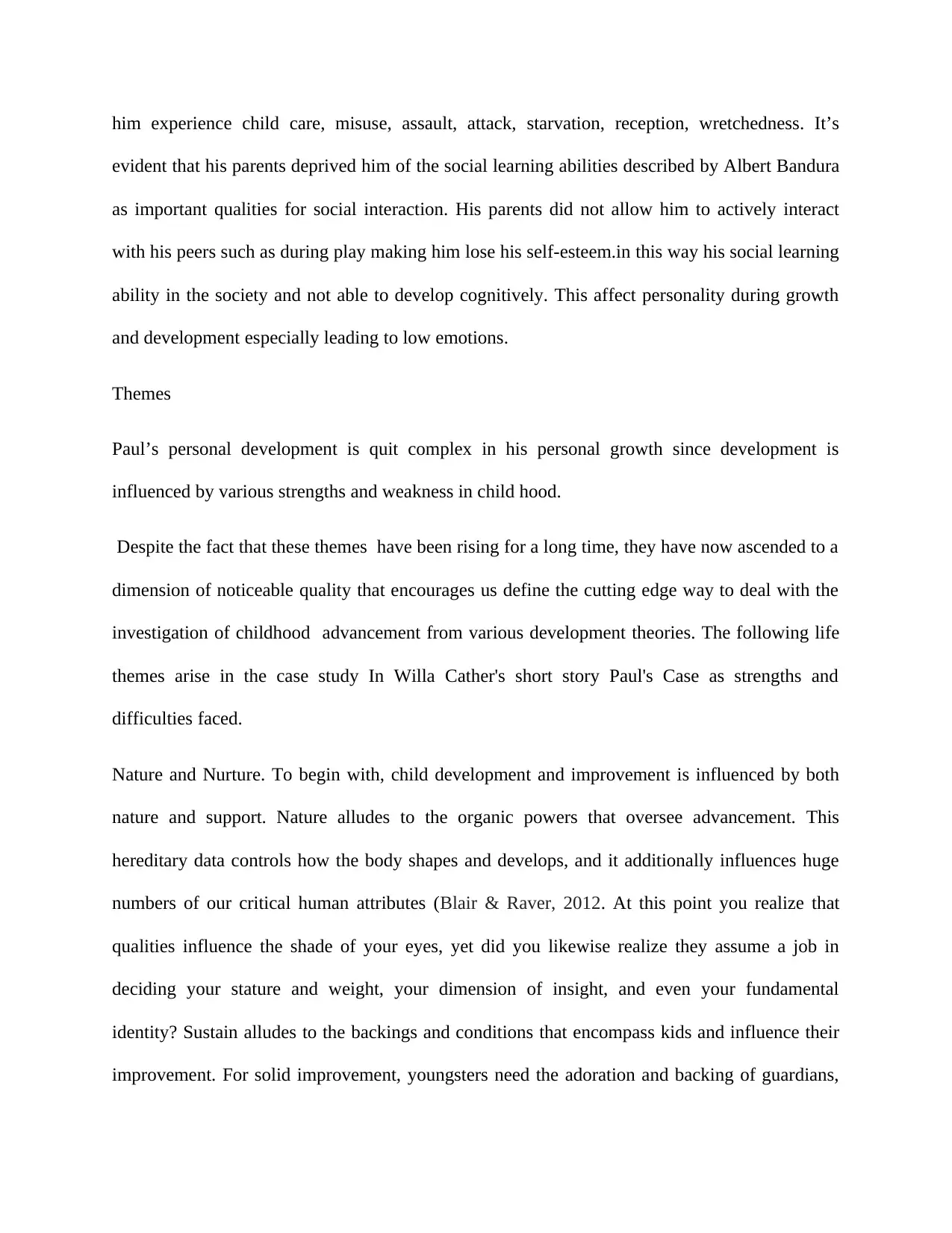
him experience child care, misuse, assault, attack, starvation, reception, wretchedness. It’s
evident that his parents deprived him of the social learning abilities described by Albert Bandura
as important qualities for social interaction. His parents did not allow him to actively interact
with his peers such as during play making him lose his self-esteem.in this way his social learning
ability in the society and not able to develop cognitively. This affect personality during growth
and development especially leading to low emotions.
Themes
Paul’s personal development is quit complex in his personal growth since development is
influenced by various strengths and weakness in child hood.
Despite the fact that these themes have been rising for a long time, they have now ascended to a
dimension of noticeable quality that encourages us define the cutting edge way to deal with the
investigation of childhood advancement from various development theories. The following life
themes arise in the case study In Willa Cather's short story Paul's Case as strengths and
difficulties faced.
Nature and Nurture. To begin with, child development and improvement is influenced by both
nature and support. Nature alludes to the organic powers that oversee advancement. This
hereditary data controls how the body shapes and develops, and it additionally influences huge
numbers of our critical human attributes (Blair & Raver, 2012. At this point you realize that
qualities influence the shade of your eyes, yet did you likewise realize they assume a job in
deciding your stature and weight, your dimension of insight, and even your fundamental
identity? Sustain alludes to the backings and conditions that encompass kids and influence their
improvement. For solid improvement, youngsters need the adoration and backing of guardians,
evident that his parents deprived him of the social learning abilities described by Albert Bandura
as important qualities for social interaction. His parents did not allow him to actively interact
with his peers such as during play making him lose his self-esteem.in this way his social learning
ability in the society and not able to develop cognitively. This affect personality during growth
and development especially leading to low emotions.
Themes
Paul’s personal development is quit complex in his personal growth since development is
influenced by various strengths and weakness in child hood.
Despite the fact that these themes have been rising for a long time, they have now ascended to a
dimension of noticeable quality that encourages us define the cutting edge way to deal with the
investigation of childhood advancement from various development theories. The following life
themes arise in the case study In Willa Cather's short story Paul's Case as strengths and
difficulties faced.
Nature and Nurture. To begin with, child development and improvement is influenced by both
nature and support. Nature alludes to the organic powers that oversee advancement. This
hereditary data controls how the body shapes and develops, and it additionally influences huge
numbers of our critical human attributes (Blair & Raver, 2012. At this point you realize that
qualities influence the shade of your eyes, yet did you likewise realize they assume a job in
deciding your stature and weight, your dimension of insight, and even your fundamental
identity? Sustain alludes to the backings and conditions that encompass kids and influence their
improvement. For solid improvement, youngsters need the adoration and backing of guardians,
Paraphrase This Document
Need a fresh take? Get an instant paraphrase of this document with our AI Paraphraser
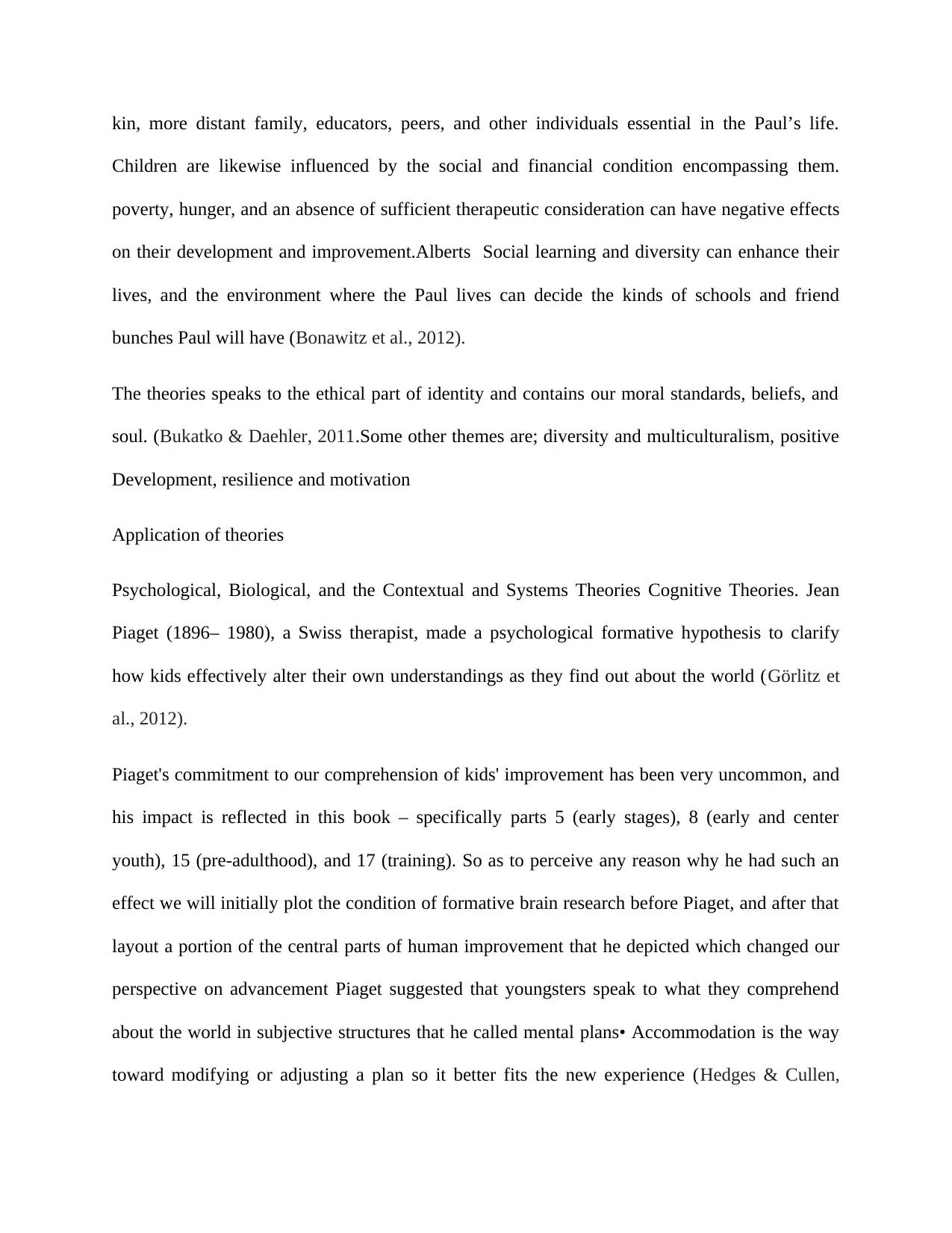
kin, more distant family, educators, peers, and other individuals essential in the Paul’s life.
Children are likewise influenced by the social and financial condition encompassing them.
poverty, hunger, and an absence of sufficient therapeutic consideration can have negative effects
on their development and improvement.Alberts Social learning and diversity can enhance their
lives, and the environment where the Paul lives can decide the kinds of schools and friend
bunches Paul will have (Bonawitz et al., 2012).
The theories speaks to the ethical part of identity and contains our moral standards, beliefs, and
soul. (Bukatko & Daehler, 2011.Some other themes are; diversity and multiculturalism, positive
Development, resilience and motivation
Application of theories
Psychological, Biological, and the Contextual and Systems Theories Cognitive Theories. Jean
Piaget (1896– 1980), a Swiss therapist, made a psychological formative hypothesis to clarify
how kids effectively alter their own understandings as they find out about the world (Görlitz et
al., 2012).
Piaget's commitment to our comprehension of kids' improvement has been very uncommon, and
his impact is reflected in this book – specifically parts 5 (early stages), 8 (early and center
youth), 15 (pre-adulthood), and 17 (training). So as to perceive any reason why he had such an
effect we will initially plot the condition of formative brain research before Piaget, and after that
layout a portion of the central parts of human improvement that he depicted which changed our
perspective on advancement Piaget suggested that youngsters speak to what they comprehend
about the world in subjective structures that he called mental plans• Accommodation is the way
toward modifying or adjusting a plan so it better fits the new experience (Hedges & Cullen,
Children are likewise influenced by the social and financial condition encompassing them.
poverty, hunger, and an absence of sufficient therapeutic consideration can have negative effects
on their development and improvement.Alberts Social learning and diversity can enhance their
lives, and the environment where the Paul lives can decide the kinds of schools and friend
bunches Paul will have (Bonawitz et al., 2012).
The theories speaks to the ethical part of identity and contains our moral standards, beliefs, and
soul. (Bukatko & Daehler, 2011.Some other themes are; diversity and multiculturalism, positive
Development, resilience and motivation
Application of theories
Psychological, Biological, and the Contextual and Systems Theories Cognitive Theories. Jean
Piaget (1896– 1980), a Swiss therapist, made a psychological formative hypothesis to clarify
how kids effectively alter their own understandings as they find out about the world (Görlitz et
al., 2012).
Piaget's commitment to our comprehension of kids' improvement has been very uncommon, and
his impact is reflected in this book – specifically parts 5 (early stages), 8 (early and center
youth), 15 (pre-adulthood), and 17 (training). So as to perceive any reason why he had such an
effect we will initially plot the condition of formative brain research before Piaget, and after that
layout a portion of the central parts of human improvement that he depicted which changed our
perspective on advancement Piaget suggested that youngsters speak to what they comprehend
about the world in subjective structures that he called mental plans• Accommodation is the way
toward modifying or adjusting a plan so it better fits the new experience (Hedges & Cullen,
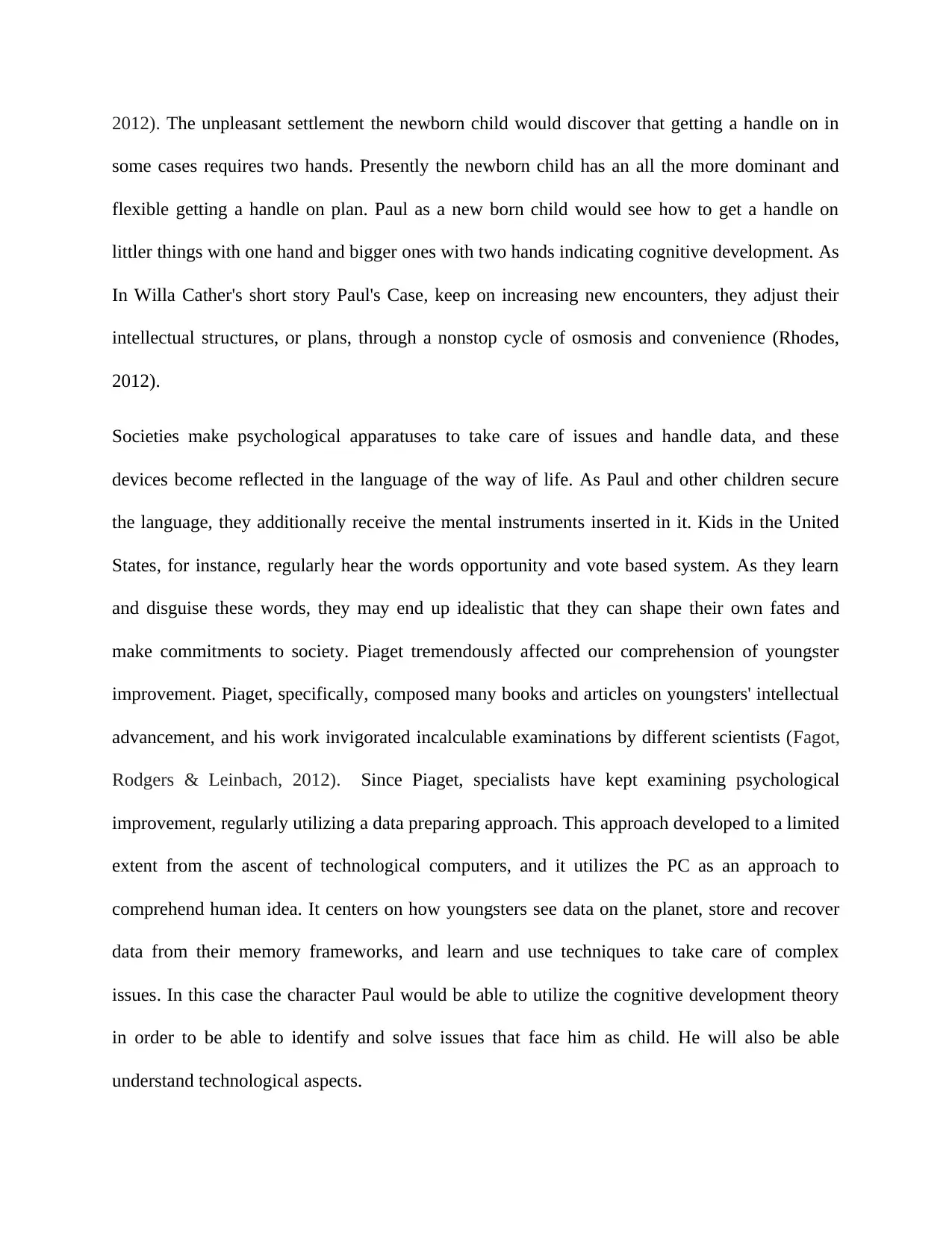
2012). The unpleasant settlement the newborn child would discover that getting a handle on in
some cases requires two hands. Presently the newborn child has an all the more dominant and
flexible getting a handle on plan. Paul as a new born child would see how to get a handle on
littler things with one hand and bigger ones with two hands indicating cognitive development. As
In Willa Cather's short story Paul's Case, keep on increasing new encounters, they adjust their
intellectual structures, or plans, through a nonstop cycle of osmosis and convenience (Rhodes,
2012).
Societies make psychological apparatuses to take care of issues and handle data, and these
devices become reflected in the language of the way of life. As Paul and other children secure
the language, they additionally receive the mental instruments inserted in it. Kids in the United
States, for instance, regularly hear the words opportunity and vote based system. As they learn
and disguise these words, they may end up idealistic that they can shape their own fates and
make commitments to society. Piaget tremendously affected our comprehension of youngster
improvement. Piaget, specifically, composed many books and articles on youngsters' intellectual
advancement, and his work invigorated incalculable examinations by different scientists (Fagot,
Rodgers & Leinbach, 2012). Since Piaget, specialists have kept examining psychological
improvement, regularly utilizing a data preparing approach. This approach developed to a limited
extent from the ascent of technological computers, and it utilizes the PC as an approach to
comprehend human idea. It centers on how youngsters see data on the planet, store and recover
data from their memory frameworks, and learn and use techniques to take care of complex
issues. In this case the character Paul would be able to utilize the cognitive development theory
in order to be able to identify and solve issues that face him as child. He will also be able
understand technological aspects.
some cases requires two hands. Presently the newborn child has an all the more dominant and
flexible getting a handle on plan. Paul as a new born child would see how to get a handle on
littler things with one hand and bigger ones with two hands indicating cognitive development. As
In Willa Cather's short story Paul's Case, keep on increasing new encounters, they adjust their
intellectual structures, or plans, through a nonstop cycle of osmosis and convenience (Rhodes,
2012).
Societies make psychological apparatuses to take care of issues and handle data, and these
devices become reflected in the language of the way of life. As Paul and other children secure
the language, they additionally receive the mental instruments inserted in it. Kids in the United
States, for instance, regularly hear the words opportunity and vote based system. As they learn
and disguise these words, they may end up idealistic that they can shape their own fates and
make commitments to society. Piaget tremendously affected our comprehension of youngster
improvement. Piaget, specifically, composed many books and articles on youngsters' intellectual
advancement, and his work invigorated incalculable examinations by different scientists (Fagot,
Rodgers & Leinbach, 2012). Since Piaget, specialists have kept examining psychological
improvement, regularly utilizing a data preparing approach. This approach developed to a limited
extent from the ascent of technological computers, and it utilizes the PC as an approach to
comprehend human idea. It centers on how youngsters see data on the planet, store and recover
data from their memory frameworks, and learn and use techniques to take care of complex
issues. In this case the character Paul would be able to utilize the cognitive development theory
in order to be able to identify and solve issues that face him as child. He will also be able
understand technological aspects.
⊘ This is a preview!⊘
Do you want full access?
Subscribe today to unlock all pages.

Trusted by 1+ million students worldwide
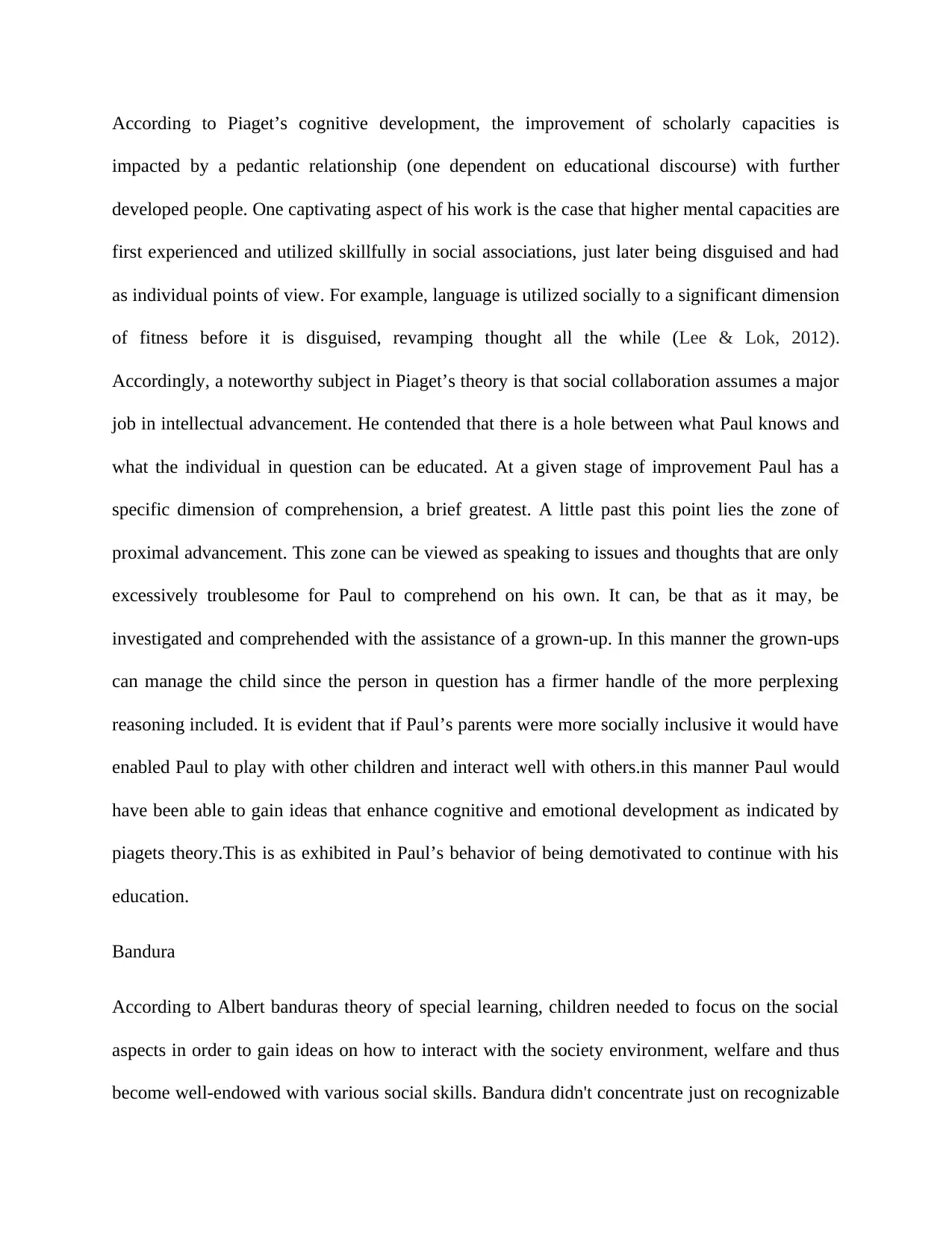
According to Piaget’s cognitive development, the improvement of scholarly capacities is
impacted by a pedantic relationship (one dependent on educational discourse) with further
developed people. One captivating aspect of his work is the case that higher mental capacities are
first experienced and utilized skillfully in social associations, just later being disguised and had
as individual points of view. For example, language is utilized socially to a significant dimension
of fitness before it is disguised, revamping thought all the while (Lee & Lok, 2012).
Accordingly, a noteworthy subject in Piaget’s theory is that social collaboration assumes a major
job in intellectual advancement. He contended that there is a hole between what Paul knows and
what the individual in question can be educated. At a given stage of improvement Paul has a
specific dimension of comprehension, a brief greatest. A little past this point lies the zone of
proximal advancement. This zone can be viewed as speaking to issues and thoughts that are only
excessively troublesome for Paul to comprehend on his own. It can, be that as it may, be
investigated and comprehended with the assistance of a grown-up. In this manner the grown-ups
can manage the child since the person in question has a firmer handle of the more perplexing
reasoning included. It is evident that if Paul’s parents were more socially inclusive it would have
enabled Paul to play with other children and interact well with others.in this manner Paul would
have been able to gain ideas that enhance cognitive and emotional development as indicated by
piagets theory.This is as exhibited in Paul’s behavior of being demotivated to continue with his
education.
Bandura
According to Albert banduras theory of special learning, children needed to focus on the social
aspects in order to gain ideas on how to interact with the society environment, welfare and thus
become well-endowed with various social skills. Bandura didn't concentrate just on recognizable
impacted by a pedantic relationship (one dependent on educational discourse) with further
developed people. One captivating aspect of his work is the case that higher mental capacities are
first experienced and utilized skillfully in social associations, just later being disguised and had
as individual points of view. For example, language is utilized socially to a significant dimension
of fitness before it is disguised, revamping thought all the while (Lee & Lok, 2012).
Accordingly, a noteworthy subject in Piaget’s theory is that social collaboration assumes a major
job in intellectual advancement. He contended that there is a hole between what Paul knows and
what the individual in question can be educated. At a given stage of improvement Paul has a
specific dimension of comprehension, a brief greatest. A little past this point lies the zone of
proximal advancement. This zone can be viewed as speaking to issues and thoughts that are only
excessively troublesome for Paul to comprehend on his own. It can, be that as it may, be
investigated and comprehended with the assistance of a grown-up. In this manner the grown-ups
can manage the child since the person in question has a firmer handle of the more perplexing
reasoning included. It is evident that if Paul’s parents were more socially inclusive it would have
enabled Paul to play with other children and interact well with others.in this manner Paul would
have been able to gain ideas that enhance cognitive and emotional development as indicated by
piagets theory.This is as exhibited in Paul’s behavior of being demotivated to continue with his
education.
Bandura
According to Albert banduras theory of special learning, children needed to focus on the social
aspects in order to gain ideas on how to interact with the society environment, welfare and thus
become well-endowed with various social skills. Bandura didn't concentrate just on recognizable
Paraphrase This Document
Need a fresh take? Get an instant paraphrase of this document with our AI Paraphraser
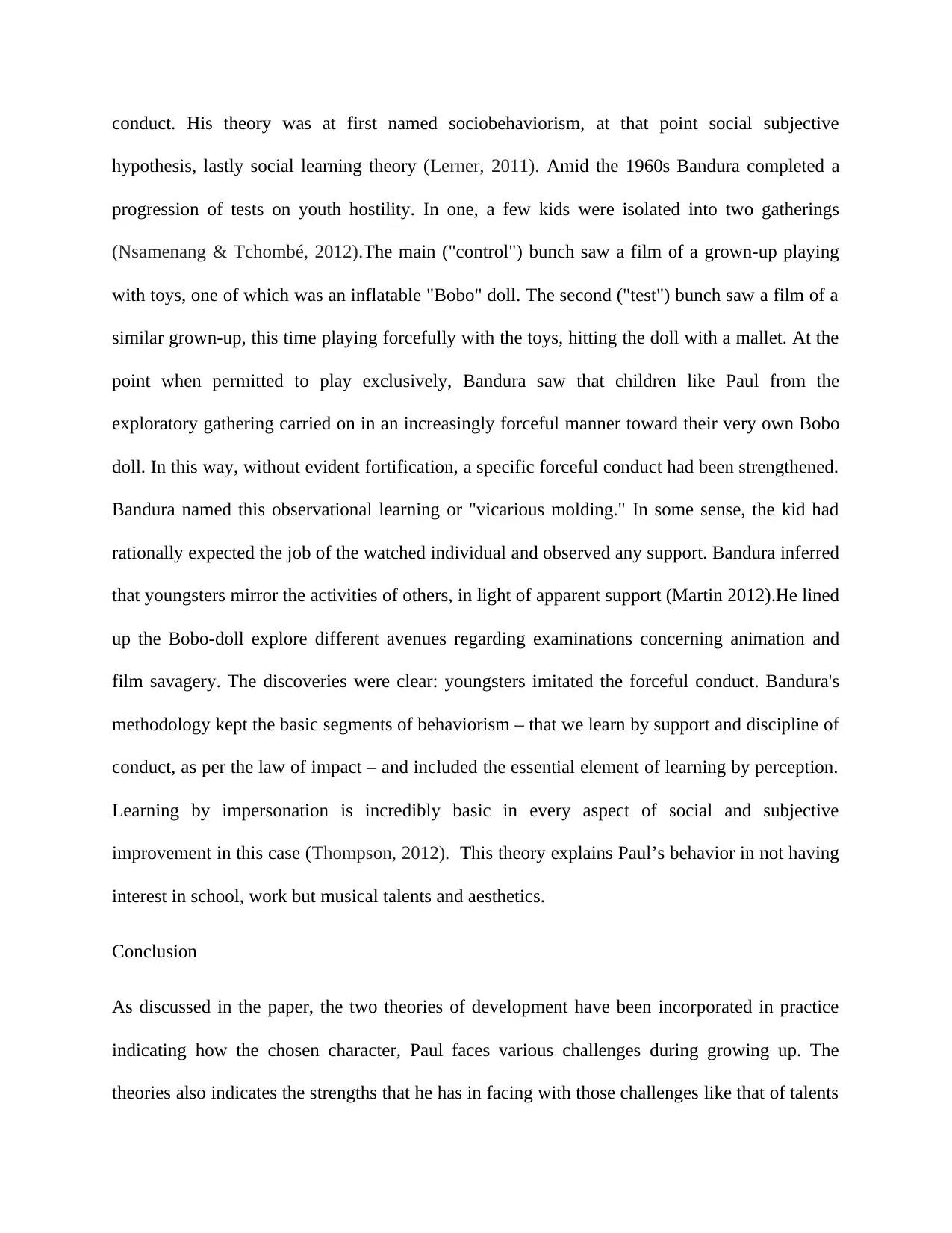
conduct. His theory was at first named sociobehaviorism, at that point social subjective
hypothesis, lastly social learning theory (Lerner, 2011). Amid the 1960s Bandura completed a
progression of tests on youth hostility. In one, a few kids were isolated into two gatherings
(Nsamenang & Tchombé, 2012).The main ("control") bunch saw a film of a grown-up playing
with toys, one of which was an inflatable "Bobo" doll. The second ("test") bunch saw a film of a
similar grown-up, this time playing forcefully with the toys, hitting the doll with a mallet. At the
point when permitted to play exclusively, Bandura saw that children like Paul from the
exploratory gathering carried on in an increasingly forceful manner toward their very own Bobo
doll. In this way, without evident fortification, a specific forceful conduct had been strengthened.
Bandura named this observational learning or "vicarious molding." In some sense, the kid had
rationally expected the job of the watched individual and observed any support. Bandura inferred
that youngsters mirror the activities of others, in light of apparent support (Martin 2012).He lined
up the Bobo-doll explore different avenues regarding examinations concerning animation and
film savagery. The discoveries were clear: youngsters imitated the forceful conduct. Bandura's
methodology kept the basic segments of behaviorism – that we learn by support and discipline of
conduct, as per the law of impact – and included the essential element of learning by perception.
Learning by impersonation is incredibly basic in every aspect of social and subjective
improvement in this case (Thompson, 2012). This theory explains Paul’s behavior in not having
interest in school, work but musical talents and aesthetics.
Conclusion
As discussed in the paper, the two theories of development have been incorporated in practice
indicating how the chosen character, Paul faces various challenges during growing up. The
theories also indicates the strengths that he has in facing with those challenges like that of talents
hypothesis, lastly social learning theory (Lerner, 2011). Amid the 1960s Bandura completed a
progression of tests on youth hostility. In one, a few kids were isolated into two gatherings
(Nsamenang & Tchombé, 2012).The main ("control") bunch saw a film of a grown-up playing
with toys, one of which was an inflatable "Bobo" doll. The second ("test") bunch saw a film of a
similar grown-up, this time playing forcefully with the toys, hitting the doll with a mallet. At the
point when permitted to play exclusively, Bandura saw that children like Paul from the
exploratory gathering carried on in an increasingly forceful manner toward their very own Bobo
doll. In this way, without evident fortification, a specific forceful conduct had been strengthened.
Bandura named this observational learning or "vicarious molding." In some sense, the kid had
rationally expected the job of the watched individual and observed any support. Bandura inferred
that youngsters mirror the activities of others, in light of apparent support (Martin 2012).He lined
up the Bobo-doll explore different avenues regarding examinations concerning animation and
film savagery. The discoveries were clear: youngsters imitated the forceful conduct. Bandura's
methodology kept the basic segments of behaviorism – that we learn by support and discipline of
conduct, as per the law of impact – and included the essential element of learning by perception.
Learning by impersonation is incredibly basic in every aspect of social and subjective
improvement in this case (Thompson, 2012). This theory explains Paul’s behavior in not having
interest in school, work but musical talents and aesthetics.
Conclusion
As discussed in the paper, the two theories of development have been incorporated in practice
indicating how the chosen character, Paul faces various challenges during growing up. The
theories also indicates the strengths that he has in facing with those challenges like that of talents
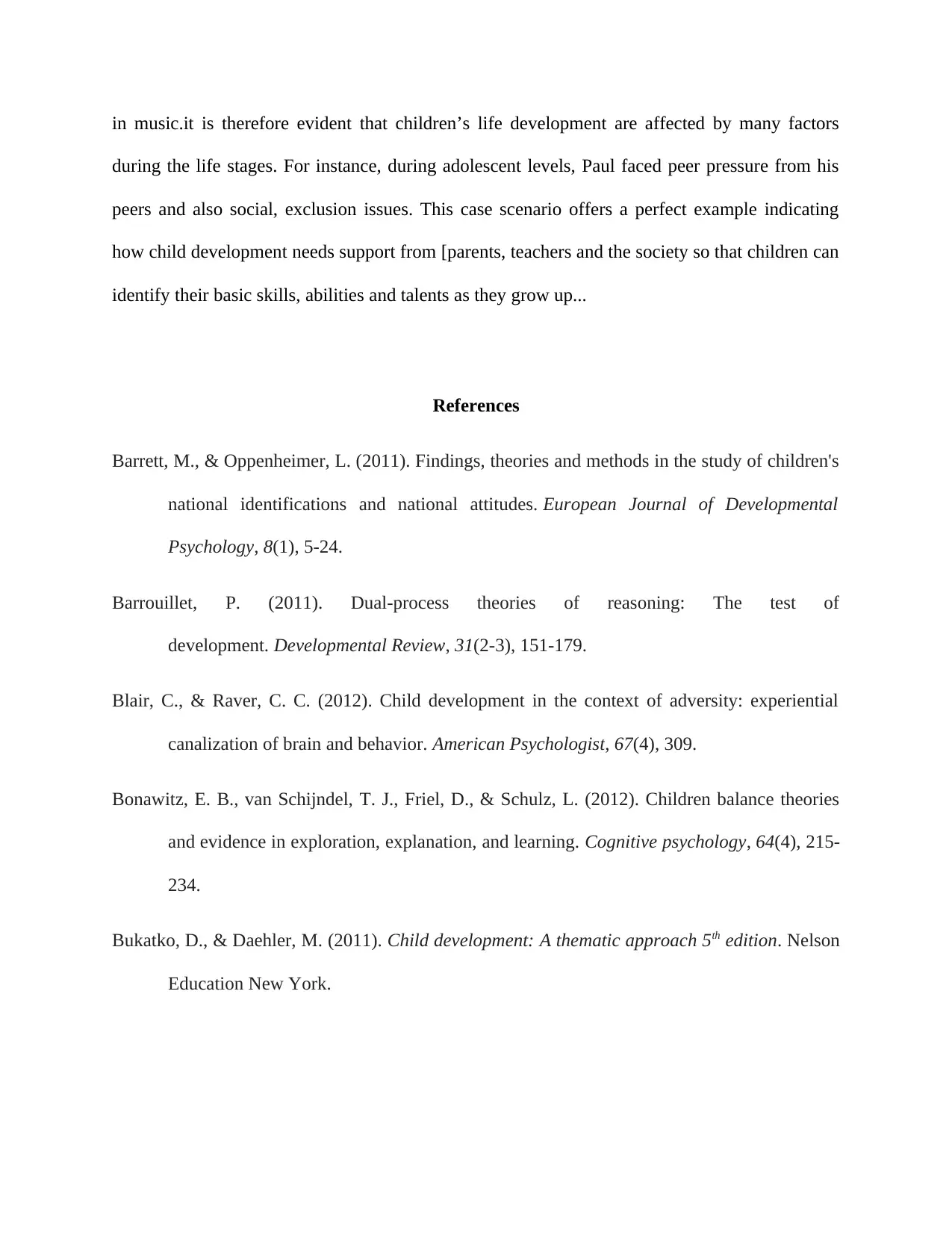
in music.it is therefore evident that children’s life development are affected by many factors
during the life stages. For instance, during adolescent levels, Paul faced peer pressure from his
peers and also social, exclusion issues. This case scenario offers a perfect example indicating
how child development needs support from [parents, teachers and the society so that children can
identify their basic skills, abilities and talents as they grow up...
References
Barrett, M., & Oppenheimer, L. (2011). Findings, theories and methods in the study of children's
national identifications and national attitudes. European Journal of Developmental
Psychology, 8(1), 5-24.
Barrouillet, P. (2011). Dual-process theories of reasoning: The test of
development. Developmental Review, 31(2-3), 151-179.
Blair, C., & Raver, C. C. (2012). Child development in the context of adversity: experiential
canalization of brain and behavior. American Psychologist, 67(4), 309.
Bonawitz, E. B., van Schijndel, T. J., Friel, D., & Schulz, L. (2012). Children balance theories
and evidence in exploration, explanation, and learning. Cognitive psychology, 64(4), 215-
234.
Bukatko, D., & Daehler, M. (2011). Child development: A thematic approach 5th edition. Nelson
Education New York.
during the life stages. For instance, during adolescent levels, Paul faced peer pressure from his
peers and also social, exclusion issues. This case scenario offers a perfect example indicating
how child development needs support from [parents, teachers and the society so that children can
identify their basic skills, abilities and talents as they grow up...
References
Barrett, M., & Oppenheimer, L. (2011). Findings, theories and methods in the study of children's
national identifications and national attitudes. European Journal of Developmental
Psychology, 8(1), 5-24.
Barrouillet, P. (2011). Dual-process theories of reasoning: The test of
development. Developmental Review, 31(2-3), 151-179.
Blair, C., & Raver, C. C. (2012). Child development in the context of adversity: experiential
canalization of brain and behavior. American Psychologist, 67(4), 309.
Bonawitz, E. B., van Schijndel, T. J., Friel, D., & Schulz, L. (2012). Children balance theories
and evidence in exploration, explanation, and learning. Cognitive psychology, 64(4), 215-
234.
Bukatko, D., & Daehler, M. (2011). Child development: A thematic approach 5th edition. Nelson
Education New York.
⊘ This is a preview!⊘
Do you want full access?
Subscribe today to unlock all pages.

Trusted by 1+ million students worldwide
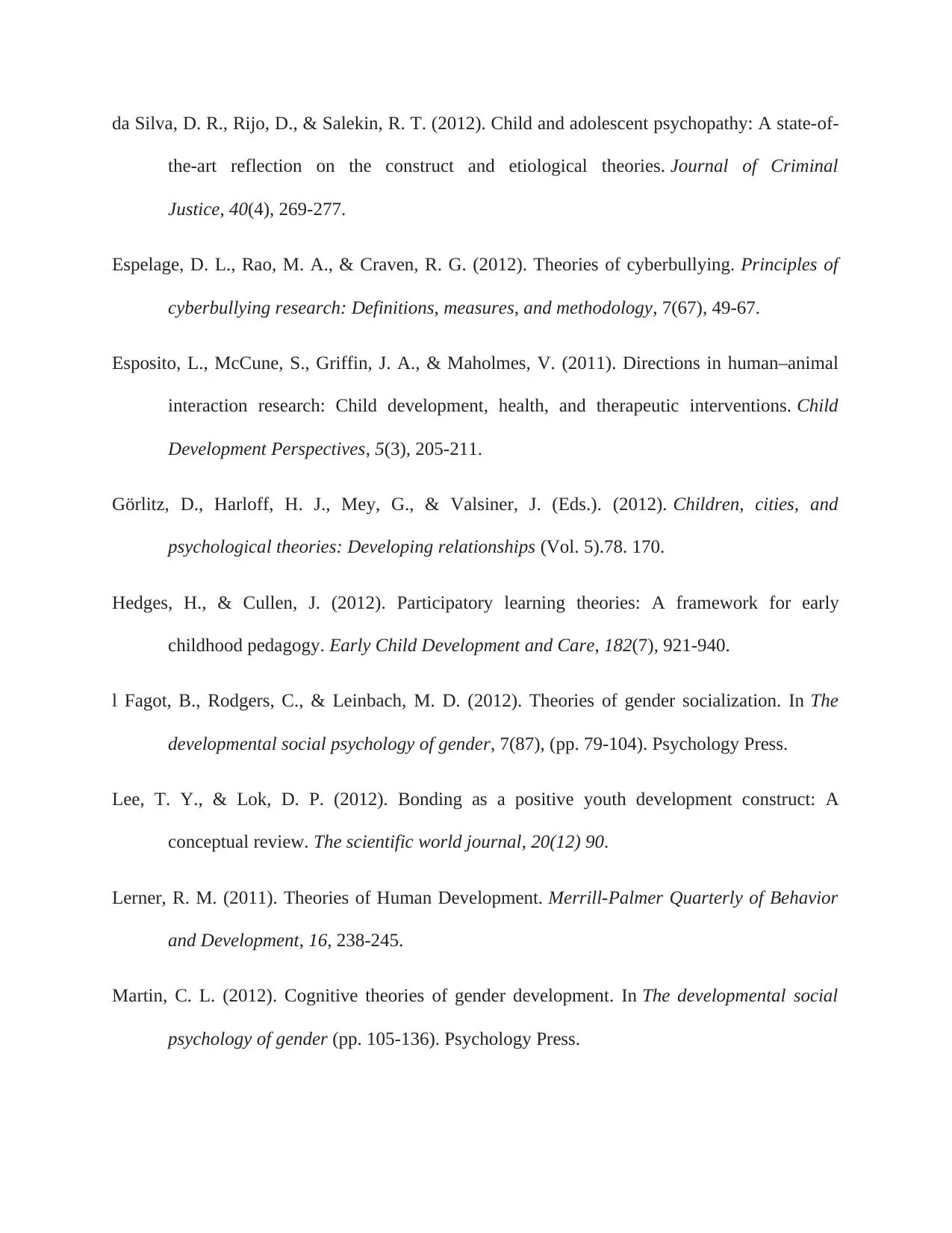
da Silva, D. R., Rijo, D., & Salekin, R. T. (2012). Child and adolescent psychopathy: A state-of-
the-art reflection on the construct and etiological theories. Journal of Criminal
Justice, 40(4), 269-277.
Espelage, D. L., Rao, M. A., & Craven, R. G. (2012). Theories of cyberbullying. Principles of
cyberbullying research: Definitions, measures, and methodology, 7(67), 49-67.
Esposito, L., McCune, S., Griffin, J. A., & Maholmes, V. (2011). Directions in human–animal
interaction research: Child development, health, and therapeutic interventions. Child
Development Perspectives, 5(3), 205-211.
Görlitz, D., Harloff, H. J., Mey, G., & Valsiner, J. (Eds.). (2012). Children, cities, and
psychological theories: Developing relationships (Vol. 5).78. 170.
Hedges, H., & Cullen, J. (2012). Participatory learning theories: A framework for early
childhood pedagogy. Early Child Development and Care, 182(7), 921-940.
l Fagot, B., Rodgers, C., & Leinbach, M. D. (2012). Theories of gender socialization. In The
developmental social psychology of gender, 7(87), (pp. 79-104). Psychology Press.
Lee, T. Y., & Lok, D. P. (2012). Bonding as a positive youth development construct: A
conceptual review. The scientific world journal, 20(12) 90.
Lerner, R. M. (2011). Theories of Human Development. Merrill-Palmer Quarterly of Behavior
and Development, 16, 238-245.
Martin, C. L. (2012). Cognitive theories of gender development. In The developmental social
psychology of gender (pp. 105-136). Psychology Press.
the-art reflection on the construct and etiological theories. Journal of Criminal
Justice, 40(4), 269-277.
Espelage, D. L., Rao, M. A., & Craven, R. G. (2012). Theories of cyberbullying. Principles of
cyberbullying research: Definitions, measures, and methodology, 7(67), 49-67.
Esposito, L., McCune, S., Griffin, J. A., & Maholmes, V. (2011). Directions in human–animal
interaction research: Child development, health, and therapeutic interventions. Child
Development Perspectives, 5(3), 205-211.
Görlitz, D., Harloff, H. J., Mey, G., & Valsiner, J. (Eds.). (2012). Children, cities, and
psychological theories: Developing relationships (Vol. 5).78. 170.
Hedges, H., & Cullen, J. (2012). Participatory learning theories: A framework for early
childhood pedagogy. Early Child Development and Care, 182(7), 921-940.
l Fagot, B., Rodgers, C., & Leinbach, M. D. (2012). Theories of gender socialization. In The
developmental social psychology of gender, 7(87), (pp. 79-104). Psychology Press.
Lee, T. Y., & Lok, D. P. (2012). Bonding as a positive youth development construct: A
conceptual review. The scientific world journal, 20(12) 90.
Lerner, R. M. (2011). Theories of Human Development. Merrill-Palmer Quarterly of Behavior
and Development, 16, 238-245.
Martin, C. L. (2012). Cognitive theories of gender development. In The developmental social
psychology of gender (pp. 105-136). Psychology Press.
Paraphrase This Document
Need a fresh take? Get an instant paraphrase of this document with our AI Paraphraser
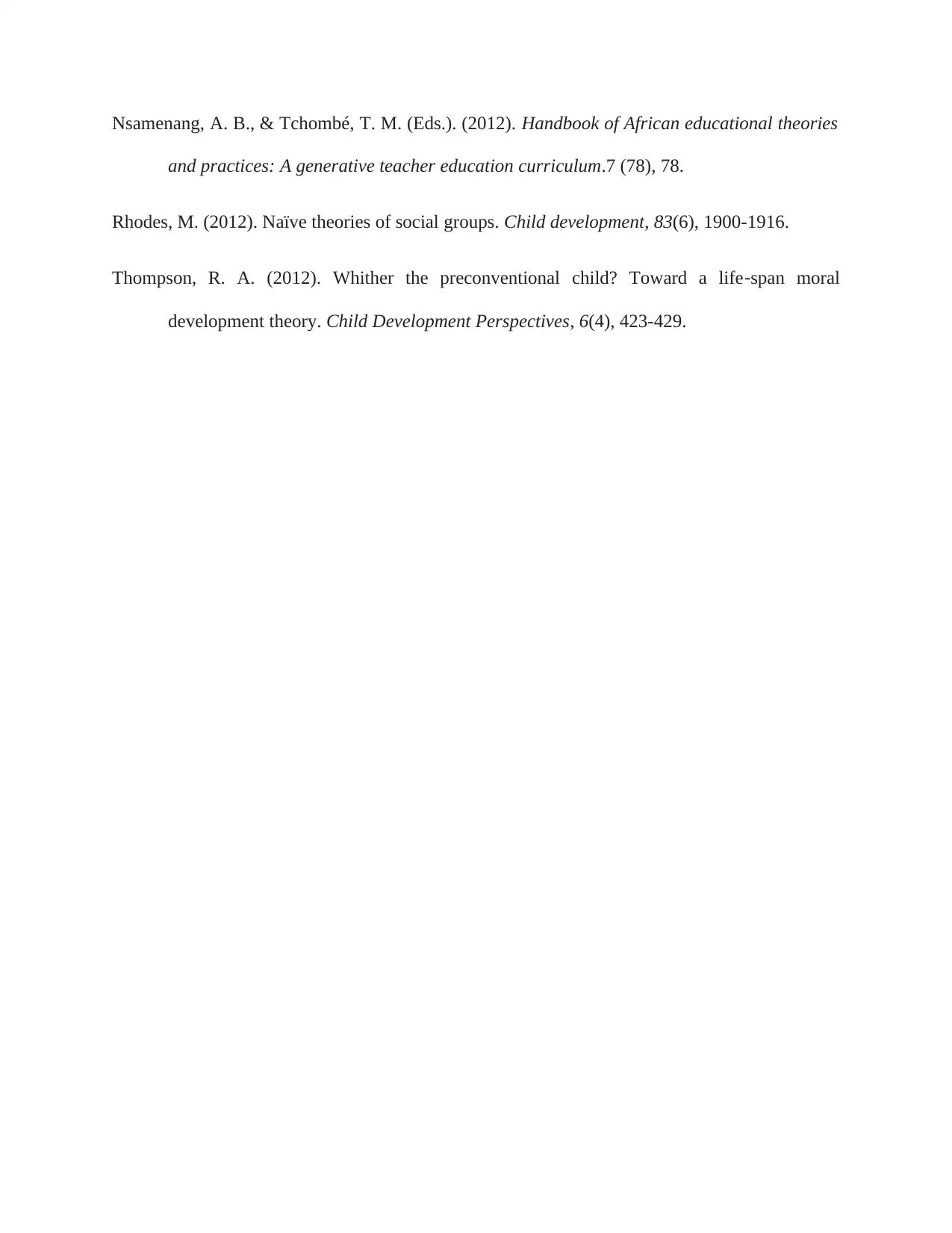
Nsamenang, A. B., & Tchombé, T. M. (Eds.). (2012). Handbook of African educational theories
and practices: A generative teacher education curriculum.7 (78), 78.
Rhodes, M. (2012). Naïve theories of social groups. Child development, 83(6), 1900-1916.
Thompson, R. A. (2012). Whither the preconventional child? Toward a life‐span moral
development theory. Child Development Perspectives, 6(4), 423-429.
and practices: A generative teacher education curriculum.7 (78), 78.
Rhodes, M. (2012). Naïve theories of social groups. Child development, 83(6), 1900-1916.
Thompson, R. A. (2012). Whither the preconventional child? Toward a life‐span moral
development theory. Child Development Perspectives, 6(4), 423-429.
1 out of 11
Related Documents
Your All-in-One AI-Powered Toolkit for Academic Success.
+13062052269
info@desklib.com
Available 24*7 on WhatsApp / Email
![[object Object]](/_next/static/media/star-bottom.7253800d.svg)
Unlock your academic potential
Copyright © 2020–2025 A2Z Services. All Rights Reserved. Developed and managed by ZUCOL.





